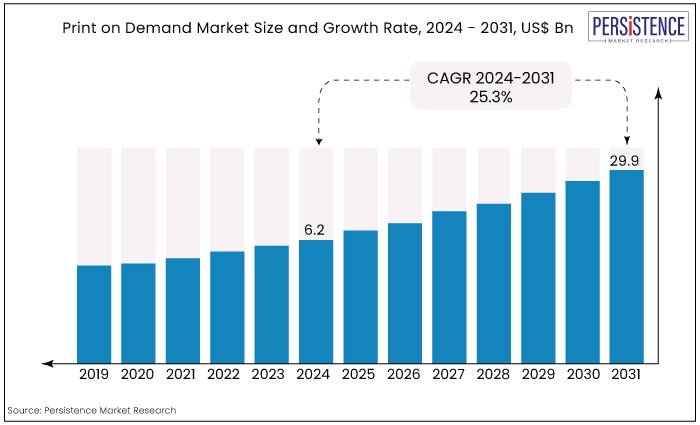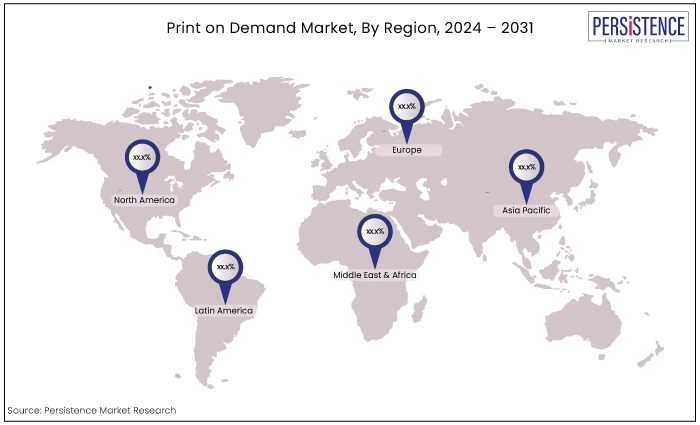Industry: IT and Telecommunication
Published Date: July-2024
Format: PPT*, PDF, EXCEL
Delivery Timelines: Contact Sales
Number of Pages: 157
Report ID: PMRREP34702
The market for print on demand was estimated at US$6.2 Bn in 2024 and is expected to be valued at US$29.9 Bn by 2031. The market for print on demand is anticipated to achieve a growth rate of 25.3% from 2024 to 2031.
Key Highlights of the Market
|
Attributes |
Key Insights |
|
Market Size (2024E) |
US$6.2 Bn |
|
Projected Market Value (2031F) |
US$29.9 Bn |
|
Forecast Growth Rate (CAGR 2024 to 2031) |
25.3% |
|
Historical Growth Rate (CAGR 2018 to 2023) |
22.4% |
The print on demand market refers to a business model where products, such as books, apparel, and home decor, are produced only when an order is placed by a customer.
The market's revenue was valued at US$6.2 Bn in 2024 and is projected to grow at a robust CAGR of over 25.3% from 2024 to 2031. The market is expanding due to the demand for personalized products, preference for fashion apparel, technological infrastructure, stable economies, and the availability of factories to produce print on demand products.
The expanded use of online platforms for purchasing clothing and the rising demand for customized products are fueling market growth.
Consumers are increasingly looking for unique and personalized products, and print-on-demand allows for easy customization and quick delivery. This is fueling market expansion, which is expected to reach US$29.9 Bn by 2031.
Technological advancements are one of the most important market trends. Advancements such as digitalization and e-commerce play a significant role in the growth of the print on demand market shares.
As more people stay at home and look to improve their home environment, there is an expected boost in industry sales. PMR shows a steady perspective for the market.
The market growth is pushed by increasing demand for personalized products, rising disposable income, internet penetration, and a preference for fashion apparel.

The print-on-demand industry has experienced significant growth in recent years, driven by various factors such as technological advancements, changing consumer preferences, demand for personalized products, preference for fashion apparel, and the rise of e-commerce.
The print on demand market analysis shows that the market has the potential to grow significantly. The market was valued at US$2.2 Bn in 2019, increasing robustly at a CAGR of 22.4% from 2019 to 2023.
Since then, the market has been accelerating immensely and is expected to reach US$6.2 Bn in 2024. Rapidly changing fashion trends and increased demand for sustainable printing are some of the major factors fueling market growth.
This availability of various product categories, such as home decor, books, and educational resources, is creating an increase in market sales. The COVID-19 pandemic had a positive impact on the print on demand industry, as it highlighted the importance of e-commerce and the need for flexible and customizable products, which further fueled the growth of the market.
E-commerce Expansion and Convenience
The rapid expansion of e-commerce platforms has been a major growth driver for the market. Online marketplaces and digital storefronts provide a convenient and accessible platform for sellers to offer print on demand products to a global customer base.
With the increasing popularity of online shopping and the ease of setting up an online store, more entrepreneurs and businesses are entering the market, fueling its growth.
Increasing Demand for Customization and Personalization
Consumers today seek unique and personalized products that reflect their individuality. The print on demand industry offers a wide range of customizable options, allowing customers to personalize products with their designs, images, or text.
The demand for customization has been a significant print on demand market growth driver, as it enables customers to create one-of-a-kind products that align with their preferences and style.
Advancements in Printing Technology
Technological advancements in printing technology have played a crucial role in the growth of the market.
Digital printing techniques have become more sophisticated, enabling the high-quality and cost-effective production of customized products in smaller quantities. This has eliminated the need for traditional mass production methods and large inventory, making print on demand a viable and scalable business model.
The advancements in printing technology have also led to faster turnaround times and improved product quality, further driving market growth.
Competition and Market Saturation
As the print on demand market continues to grow, competition among sellers and platforms has intensified. The market has become saturated with numerous sellers offering similar products, making it challenging for individual sellers to stand out and attract customers.
Additionally, market saturation can lead to a dilution of product quality and customer trust, making it harder for new entrants to gain traction.
Quality Control, and Customer Satisfaction
Maintaining consistent product quality and ensuring customer satisfaction can be a significant challenge in the market. As products are produced on demand, there is a reliance on third-party printing and fulfillment services.
Issues such as printing errors, shipping delays, or poor product quality can negatively impact customer experience and damage a seller's reputation. Maintaining strict quality control measures and addressing customer concerns promptly are crucial to building trust and retaining customers in this competitive market.
International Expansion, and Global Reach
The market for print on demand has immense potential for international expansion and reaching a global customer base. As cross-border e-commerce continues to grow, sellers can leverage print on demand to cater to customers worldwide.
By partnering with international fulfilment centers and optimizing shipping logistics, sellers can tap into new markets and offer their products to customers in different regions. This global reach opens up opportunities for increased sales, brand exposure, and the ability to target niche markets in various countries.
Collaborations with Influencers, and Brands
Collaborations with influencers and brands present a promising print on demand market opportunity. Influencers and brand partnerships can help drive product awareness, boost sales, and enhance brand credibility.
By collaborating with influencers, sellers can leverage their reach and influence to promote print on demand products to their followers.
Similarly, partnering with established brands allows sellers to tap into their existing customer base and benefit from brand association. These collaborations can lead to increased visibility, customer trust, and ultimately, business growth.
Service Accounts for Maximum Sales in the Platform Segment
Based on the platform, the service segment dominates and is expected to grow, offering drop shipping, fulfillment, marketing, branding, and creative services.
The software segment, which includes APIs and design-creation tools, contributes significantly to revenue and is fueled by technology investments from service providers. This expansion enables seamless integration of online stores with print on demand platforms, providing merchants with convenience and options.
Apparel Leads the Way in Product Segment
Based on products, the apparel segment holds the largest revenue share and is projected to maintain its position due to internet retail's impact on fashion, the demand for unique items among younger consumers, and the popularity of fashion clothing.
The home décor segment is expected to grow as more people worldwide work remotely and seek to enhance their living spaces. A wide variety of home and lifestyle products, such as mats, pillows, and posters, provide customers with more options, driving sales.
Digital Printing at the Forefront
Based on technology, digital printing dominates the industry due to its versatility and affordability, enabling fast turnaround, high-quality printing, and customized runs for books, promotional materials, and sportswear.
Offset printing remains important for large print runs, offering exceptional quality for periodicals, newspapers, and packaging, making it valuable for print on demand's long runs.
Online Distribution Channels Gaining Traction in the Market
Based on the distribution channel, online distribution channels have experienced significant growth due to increased internet usage and the rise of e-commerce platforms.
Online marketplaces, websites, and e-commerce platforms offer print-on-demand services, allowing customers to easily customize garments, home décor, and promotional items.
E-Commerce Leads the End User Segmentation
Based on the end user, e-commerce holds a significant share, allowing online businesses to offer custom garments, accessories, and home decor.
Publishing is growing slowly and is expected to be popular in upcoming years. It reduces inventory and production costs for books, magazines, and other products, fueling the print on demand market expansion.
North America Building the Surface for the Print on Demand Market Expansion
North America holds the largest share of the global market due to factors such as technological infrastructure, production facilities, and strong economies.
Major print-on-demand companies like Printful, Printify, and Zazzle are headquartered in the United States. Additionally, companies like Redbubble and Gelato have fulfillment centers in North America.
Asia Pacific is expected to experience significant growth in the forecast period, driven by the presence of major market participants and advancements in technology. The region's numerous large-scale textile facilities are also anticipated to contribute to market expansion.

Recent Industry Developments
The print on demand market is actively seeking growth by acquiring established players and fostering innovation. This trend is intensified by the emergence of startups with unique offerings, creating a dynamic and competitive market landscape.
To stay ahead of evolving trends, companies are making significant investments to expand production capabilities and enhance technological features. Their goal is to develop innovative functionalities and seamlessly integrate technologies into this dynamic sector, ensuring successful market entry and widespread adoption.
|
Attributes |
Details |
|
Forecast Period |
2024 to 2031 |
|
Historical Data Available for |
2018 to 2023 |
|
Market Analysis |
US$ Billion for Value |
|
Key Country Covered |
|
|
Key Market Segments Covered |
|
|
Key Companies Profiled |
|
|
Report Coverage |
|
By Platform
By Product
By Technology
By Distribution Channel
By End User
By Regions
To know more about delivery timeline for this report Contact Sales

The market is predicted to rise from US$6.2 Bn in 2024 to US$29.9 Bn by 2031.
Increasing demand for personalized products, rising disposable income, internet penetration, and a preference for fashion apparel are propelling market growth.
Printify, Inc., Printful Inc., Canva, VistaPrint (Cimpress), and CustomCat are some examples of major industry players.
Competition among sellers and market saturation are the major factors that are restraining market expansion.
Potential for international expansion, and collaborations with influencers and brands are the major factors creating opportunity.